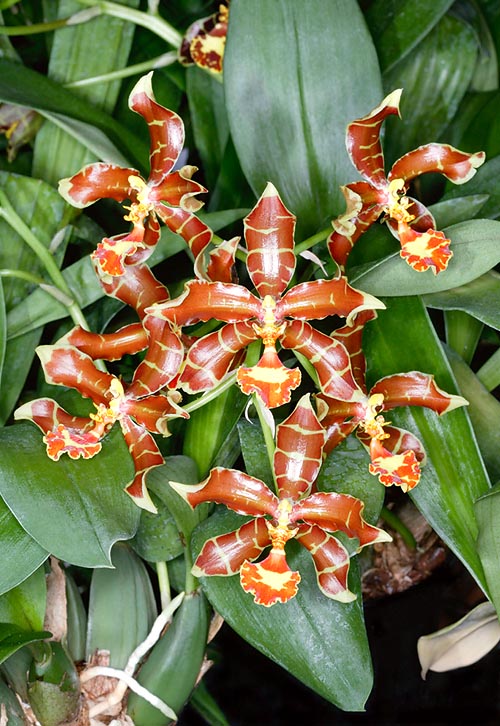Family : Orchidaceae

Text © Pietro Puccio

English translation by Mario Beltramini

The Rossioglossum insleayi inflorescences reach the 35 cm © Giuseppe Mazza
The name of the genus is the combination of the name of the orchids collector, John Ross, who discovered it in Mexico around the 1838, and the Greek term “glossa” = tongue; the species is honoured to the English collector George Baker’s head gardener, Mr. Insleay, in whose greenhouse it did flower for the first time in Europe.
The Rossioglossum insleayi (Baker ex Lindl.) Garay & G.C.Kenn. (1976) is an epiphytic species with short rhizome from which originate flattened ovoid pseudobulbs, 7-10 cm long, with at the apex 2-3 green grey elliptic and coriaceous leaves, 10-18 cm long.
The inflorescences, at the base of the pseudobulbs, are erect racemes, up to 30-35 cm long, carrying 6-10 waxy flowers, perfumed, of 7-8,5 cm of diameter.
The sepals and petals are elliptic-oblong with wavy edges, 3,5-4 cm long, of a pale yellow colour with brown red transversal spots and bands; the labellum is trilobate, about 3 cm long, with obovate median lobe, 1,8 cm broad, of bright yellow colour with brown red spots at the margins and a crest at the base with two frontal tubercles.
It reproduces by seed, in vitro, and by division, with each section provided with at least 3-4 pseudobulbs.
It is a much ornamental species, due to its long-lasting flowers, 4-6 weeks, in autumn-winter, it requires partially shaded positions, temperatures from cool to medium, with winter lowest of 10-12 °C and summer maximums preferably not exceeding the 24-26 °C and high atmospheric humidity, 60-80%, with a good air circulation.
During the vegetative period, the waterings must be abundant, reduced in winter when the pseudobulbs are completely ripe, allowing the compost to dry up before irrigating again.
Waterings and nebulisations are to be done with rain water, or water obtained by reverse osmosis or demineralised, and the fertilizations, during the vegetative period, with hydro-soluble balanced products, with microelements, at half, or less, of the dosage suggested on the package, distributed and alternated in way to avoid salts accumulation on the roots.
It can be mounted on bark or raft of cork or cultivated in pot with draining and aerated compost, being the roots sensitive to the humidity stagnations, which may be formed by medium sized bark fragments and charcoal; movements, repottings and divisions are to be done when the plant shows signs of vegetative recovery.
The species is inscribed into the appendix II of the CITES (species whose trade is internationally ruled).
Synonyms: Oncidium insleayi Baker ex Lindl. (1840); Odontoglossum insleayi (Baker ex Lindl.) Lindl. (1852).
→ For general notions about ORCHIDACEAE please click here.
